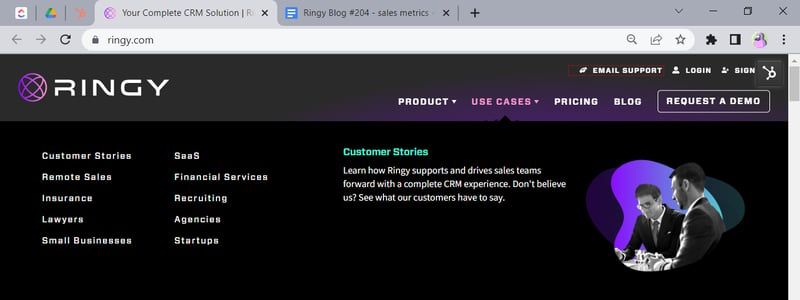
The Ultimate Guide to Sales Metrics: Everything You Need to Know
 Updated on
Updated on
By Ringy
Table of Contents
Table of Contents
Does it seem a little bit like your sales team is all over the place when it comes to nurturing leads?
Understanding exactly how your team stacks up (to past performance, to your competition, and to each other) is critical for improving sales performance.
If you're not measuring and monitoring performance, you simply don't know if the changes you're putting in place are having any significant impact.
In short, you need to be tracking sales metrics.
The problem is there are about 12.3 million metrics you can track (not the actual number, please don't look it up)-which ones should you prioritize?
In this article, we're going to explore:
- What sales metrics even are
- Why tracking metrics is critical for improving sales importance
- The top 17 metrics to consider paying attention to
- Some examples of sales metrics in action
What Are Sales Metrics?
Sales metrics are essentially performance measurements that help you understand how your sales team is doing.
Obviously, you can count the simple things like how many deals your team closes or how much revenue they generate, and these are valid metrics to keep on top of.
However, there's much more beneath the surface of sales than what happens right at the end.
Consider, for example, the metric "Pipeline stage conversion rate." This sales metric measures the percentage of leads that make it through the funnel at each pipeline stage.
This is critical for identifying skill gaps and issues with your sales process. Perhaps you're losing a lot of customers at the negotiating stage. This could be an indication that your team needs a bit of extra coaching in this area.
So, sales metrics are measurements used to track sales performance on the whole but also at the more minute level.
The Importance of Tracking Metrics for Sales Performance
![]()
Why should you bother tracking metrics for sales performance?
Four reasons:
1. Improved Performance
This one's pretty obvious, but it is the most important reason for tracking sales metrics.
Your reps improve when you focus on particular elements of the sales journey. Simple as that.
Suppose you're talking every week about how average revenue per user is growing and needs to continue doing so to reach your quarterly revenue goals. In that case, reps will focus on closing that next deal and extracting as much revenue as possible.
When you have an eye on the target, you're much more likely to hit it.
2. Better Accountability
Tracking sales metrics is super important for holding reps accountable.
Your sales team has expectations, right? You might have individual quotas or team performance measures, but you will have a target or two of some form.
You can't hold reps accountable for their targets if you're not tracking some kind of sales metric. Quota attainment, for example, is a classic metric to track for this reason.
3. Easy Identification of Coaching Opportunities
Looking only at performance measures like revenue closed per quarter doesn't tell you much about how you can help your sales reps improve other than saying, "Hey, sell better!"
But when you track very specific metrics, you have a better feel for how reps are performing and where they need support in the form of training.
For example, say your average deal size is $10,000. When you narrow in on this metric by agent, however, you spot two low performers who are closing deals averaging $7,500.
Now you've identified a specific issue that you can design a coaching program to solve.
4. Narrow In on the Things That Matter
There are literally hundreds of metrics to track (so maybe not quite 12.3 million 😊).
Almost as bad as not tracking and performance metrics is trying to keep on top of all of them.
Using sales metrics correctly means understanding which measurements are most valuable and relevant to your sales strategy and focusing only on those.
You might select a dozen and even decide to narrow down further, focusing on just half of them for the first quarter before moving on to the rest. This will help keep you and your reps focused and make you more likely to see the performance gains you're looking for.
We're about to discuss a bunch of great sales metrics. Don't feel like you need to track all of them. Pick the ones that make the most sense for your company, team, industry, customers, and sales strategy, and narrow in on those.
17 Top Sales Performance Metrics to Track

Here are 17 of our favorite sales metrics.
And if none of them work for you, then you're probably not making sales! 😛
1. Total Revenue
Total revenue is one of the most obvious sales analytics metrics to track; it's literally the amount of money your company is bringing in each year.
Obviously, we want this to be growing. If it is, then your sales team is probably doing a decent job of closing deals.
2. Annual Recurring Revenue (ARR)
Depending on your business model, you might also like to track annual recurring revenue (ARR).
This sales reporting metric is widely used by SaaS (software as a service) and subscription-based businesses because recurring revenue is the revenue they really care about.
If you have subscriptions for any kind of software (say, a sales CRM), then you can bet your bottom dollar they're tracking ARR.
They're probably tracking MRR (monthly recurring revenue) too, which is the same thing but divided by 12.
See what we mean about the possibility of monitoring too many metrics?
3. Revenue by Territory
Understanding revenue by sales territory can help with territory planning and assessing team performance (if different teams are assigned to different regions).
Depending on your specific business needs, you can track total or recurring revenue by territory.
4. Revenue by Market
Another way to split up your sales analytics metrics is to look at revenue by market.
Consider Ringy (that's us).
Our sales software serves a number of different markets:

We could track revenue by the market by comparing how much annual or recurring revenue we're seeing from insurance clients to that which we receive from recruiters.
5. Revenue by Product or Service
If you sell multiple products or services, you might also like to break revenue down by those categories.
This can help you assess and allocate sales spending accordingly (one of the sales reporting metrics which we'll discuss shortly).
6. Average Revenue Per Customer or Customer Lifetime Value (LTV)
Just as helpful as knowing how much money you're making is how much you're making from each customer.
This, again, helps you out with sales spending decisions, as you can easily calculate ROI:
We spend this much, we get this much.
7. Average Revenue Per User (ARPU)
Average revenue per user is a similar sales analytics metric mostly used by apps and software companies.
That's because this kind of organization has multiple customers, but each customer has many users.
For example, if we sell our CRM tool to a SaaS company, they might have 10 reps on their sales team (meaning they have 10 users). Our ARPU is the amount of revenue divided by the total number of users we have, not customers.
8. Deal Win Rate
We all love to win, don't we?
Deal win rate is a sales metric every organization should be tracking. It's the percentage of leads that become customers, meaning it's a high-level success measurement.
9. Market Penetration
Market penetration tells you the total share of the market that you own.
Let's use some simple numbers to illustrate:
There are 100 customers in your market. You have 10 of them. You have a 10% market penetration.
This is a helpful metric as it allows you to understand how you're faring in the market compared to your competition.
If your market share is growing, it means you're either:
- Taking more customers from your competitors, or
- The market is growing, and you're doing a better job than others at capturing that market growth
10. Percentage of Revenue From New Business/Existing Customers

This is really two sales reporting metrics in one, but they're essentially the opposite of one another, so they can be calculated at the same time.
Let's say you made $100m in revenue last year.
$90m of it came from customers you retained from the year prior (meaning the other $10m came from new clients).
This gives you the following sales performance metrics:
- Percentage of revenue from new business - 10%
- Percentage of revenue from existing customers - 90%
11. Year-On-Year Growth
Year-on-year growth looks at the percentage value your revenue grew last year.
So, you made $100m in revenue last year. This year, you made $110m, which means you drove 10% year-on-year growth.
12. Net Promoter Score (NPS)
Net Promoter Score (NPS) is a system designed to understand customer satisfaction.
The process is this:
You ask the customer, "On a scale of 1-10, how likely would you be to recommend us to friends or family?"
Then, you organize the scores as such:
|
NPS Title |
NPS Score |
|
Detractors |
1-6 |
|
Passives |
7-8 |
|
Promoters |
9-10 |
From there, you need to calculate the percentage of detractors and promoters and subtract the latter from the prior.
So, if you have the following scores:
- Detractors - 20
- Passives - 20
- Promoters - 60
Then you have these two percentages:
- Detractors - 20%
- Promoters - 60%
Substracing 20% from 60% gives you 40%, which is your Net Promoter Score.
The idea here is to get your NPS as high as possible, which is a good sign for retention but also for word of mouth, one of the most powerful sales drivers around.
Use the NPS survey directly after a sales interaction to get customer feedback on how they feel about the sales experience.
13. Quota Attainment
Quote attainment is the percentage of sales reps who achieved their quota this month, quarter, or year.
Pretty simple, but important.
14. Cost of Selling
Cost of selling is essentially how much you spent on selling activities.
This is obviously going to include sales rep salaries and commissions, but also things like:
- Sales software subscriptions
- Calling costs
- Purchase of new equipment
- Travel expenses for outside sales reps
Cost of selling is crucial for understanding the impact of your investment. You want to be spending less on sales than you're making from new sales; ideally a lot less!
15. Sales Cycle Length
Sales cycle length is the amount of time a deal takes to go from prospect to closed customers, measured in days.
It's generally measured as an average across all deals.
We want this to be as short as possible. The faster we can sell, the faster we're removing revenue, and the quicker we can get on to new sales conversations.
16. Customer Churn Rate
Customer churn rate is the percentage of customers who end their subscription with your company.
As such, it's really only suitable for SaaS and subscription revenue companies.
While churn might not be directly influenced by sales reps themselves (it's more of a customer success thing), it can show some insight.
If customers are churning quickly, your sales team might not qualify them correctly, rather getting them into a subscription they don't need.
17. Pipeline Stage Conversion Rates
Yes, you're going to measure how many prospects you convert to customers in total (that's your deal win rate).
However, pipeline stage conversion is another helpful sales performance metric to track alongside this.
Consider the typical stages in a sales pipeline:
- Prospecting
- Qualifying leads
- Initial meeting
- Define prospect needs
- Make an offer
- Negotiation
- Closing
- Delivery
You can measure conversion at each stage of the pipeline.
For example, you might see that only 10% of your prospects go through the "make an offer" stage to "negotiation." This could signify that your reps need help understanding prospect needs, or they could simply use training in the presentation aspect.
Sales Metrics Examples In Action

Okay, let's look at a few examples of sales metrics in a real-life context, so you can really understand how this whole thing works.
Cost of Selling
Calculating the cost of selling is pretty simple. You just need to add up all of the expenses your sales department accrues during a given period of time.
For example:
- Salaries: $600,000
- Commissions: $400,000
- Software: $150,000
- Calling fees: $50,000
- Office equipment: $35,000
- Travel costs: 15,000
In this case, you have a total cost of selling off $1.25m.
Now, we can look at this in a few different ways. We can divide it by the number of customers closed to understand the sales cost of acquiring a single customer.
If you closed 1500 new deals, say, you have a sales cost per customer of about $833.
We can also look at the cost of selling in terms of ROI. Say your revenue closed this year was $3.75m. You have an ROI for the cost of selling of 3x.
Sales Cycle Length
Sales cycle length is generally measured in days. You add up the total number of days taken for each deal to close (either as won or lost) and then divide that number by the number of prospects you dealt with during that period.
As a simple example:
- 28 days
- 24 days
- 32 days
- 19 days
- 37 days
Your total is 140 days, divided by 5 customers = an average sales cycle length of 28 days.
We can use this sales metric to make estimates for things like revenue growth and team resource requirements.
Sales Metric Example 3: Revenue by Market
Understanding revenue by the market is super helpful for determining how to allocate sales resources.
Imagine that right now: you have a team of 15 sales reps selling across 3 different regions:
- West Coast
- Central
- East Coast
You're closing $15m in revenue a year, but that revenue isn't split evenly. In fact, it looks more like this:
- West Coast - $8m
- Central - $2m
- East Coast - $5m
That means that the 5 reps selling into the West Coast territory are generating 4x as much revenue as those focused on the Central territory.
Obviously, you'll need to look deeper into a few other sales metrics (to ensure that the difference has to do with the territory itself and not just the reps that are assigned to each), but this could be an indication that if you simply redirected some of your resources to the West Coast territory, you'll drive more revenue without having to hire any more reps.
Frequently Asked Questions About Sales Metrics
"How to Properly Track Sales Quota Metrics?"
The best way to properly track sales quota metrics is by using a CRM platform. Virtually all CRMs these days have really powerful sales reporting and analytics suites, making it easy to set up custom dashboards so you can access real-time sales metrics when and where you need them.
That said, we'd be remiss if we didn't give ourselves a little plug here. Check out our sales reporting feature to see what we mean.
"How Many Sales Metrics Should I Track?"
Around 10 sales metrics is probably a good benchmark for most teams. The most important thing is to only track the sales metrics that matter to your team. If your sales team doesn't have any influence on churn rate, for instance, don't track it.
It's easy to fall into the trap of analyzing and poring over tonnes of different data points. Determine which metrics really drive progress to your business goals, and track those.
"Are Sales Metrics, Sales Analytics Metrics, and Sales Reporting Metrics all the Same Thing?"
In short, yes. All of these terms refer to measuring aspects of sales performance, such as the percentage of prospects that go on to become paying customers.
"What Are Sales Efficiency Metrics?"
Sales efficiency metrics are a particular kind of sales metrics that focus specifically on measuring efficiency. Common examples of sales efficiency metrics include:
- ROI (return on investment) for the cost of selling
- Deal cycle length
- Lead response time
"Are Sales Metrics and KPIs the Same?"
Sales KPIs and metrics are not the same, though they are definitely related. Sales metrics are the numbers you track. For example, you might track sales cycle length. Your sales KPIs are the benchmarks you set. You may, for instance, set the sales cycle length KPI at 24 days. If reps are below this mark, they've met the sales KPI.
|
Sales metrics |
Sales KPIs |
|
Measurements that you track to understand sales performance |
Benchmarks you set to understand if performance standards were met |
|
Example: Deal win rate |
Example: 35% |
"What Is the Best Sales Metric to Track?"
The best sales metric to track is the one that's going to push the needle the most for your team.
There's no point tracking total revenue closed if your reps don't know exactly how they make improvements toward that.
Look at the metrics we've discussed above, determine which relates most to areas your team can improve, and start there.
"What Are Sales Productivity Metrics?"
Sales productivity metrics have to do with how efficient and productive reps are. Generally, we're talking about activity-based metrics rather than results-based ones. Four examples of sales productivity metrics include:
- Time spent selling
- Number of calls made
- Emails sent
- Average time per call
"What Are the Sales Metrics that Matter?"
The sales metrics that matter most are those that are deeply relevant to your business objectives. For instance, there's no point in tracking revenue by territory if you aren't explicitly targeting different territories with different teams, strategies, or objectives. First, understand what drives revenue. Then, look at the metrics that inform progress in those areas. Track those.
Conclusion

As you can see, there are a lot of sales metrics you could track.
And, being super honest with you, we've really only touched the tip of the iceberg here. Rather than showering you with tons of potential metrics, you could track, we've curated the 17 most important ones to be aware of.
Remember, you don't need to track and measure all of them, only the ones that are most critical to your sales team's development and to driving performance toward your biggest company goals.
Once you've figured out which sales performance metrics you're going to track, the next step is to put a plan in place for actually measuring them.
A sales CRM is really the best place to do that, as it's where all of your sales data is already. You just need to choose the reports you'd like to see on a regular basis and set up a custom dashboard.
Not sure about all that? Book a demo with the Ringy team today, and we'll show you exactly how it's done.

Skyrocket your sales with the CRM that does it all.
Calling? Check. SMS? Check. Automation and AI? Check. Effortlessly keep in touch with your customers and boost your revenue without limits.

Take your sales to new heights with Ringy.
Sales in a slump? Ringy gives you the tools and flexibility you need to capture leads, engage with them, and turn them into customers.
Subscribe to Our Blog
Enter your email to get the latest updates sent straight to your inbox!
Categories
Related Articles



































































































